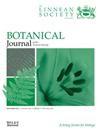There and back again: molecular phylogenetics of the Brazilian endemic Psyllocarpus (Rubiaceae: Spermacoceae) supports a circumscription of the genus based on its original concept
IF 2.2
2区 生物学
Q2 PLANT SCIENCES
引用次数: 0
Abstract
The Spermacoce clade, found primarily in the Americas, poses taxonomic challenges, notably in the unclear boundaries of Borreria and Spermacoce. These genera intertwine with smaller, morphologically distinct ones, including Psyllocarpus, a Brazilian endemic redefined into two sections. Psyllocarpus sect. Psyllocarpus, being based on the original genus delineation, encompasses nine species in the Cerrado and campo rupestre of eastern Brazil, and P. sect. Amazonica includes three species in the Amazonian campinas, while Psyllocarpus intermedius remains unclassified. Our phylogenetic study, sampling extensively across the Spermacoce clade for nuclear ribosomal (ETS and ITS) and plastid (rps16 and trnL-trnF) DNA regions and using a variety of approaches to analyse our dataset, revealed that Psyllocarpus is not monophyletic. Notably, P. campinorum (representing P. sect. Amazonica) and P. intermedius are distinct lineages in the Spermacoce clade but fall outside Psyllocarpus. Conversely, P. sect. Psyllocarpus forms a well-supported clade, closely related to Staelia. Therefore, Psyllocarpus has to be circumscribed based on its original concept, excluding P. sect. Amazonica and P. intermedius. This defines the genus as a distinct, easily diagnosable taxon. We provide a synoptic list of names and nomenclatural types of Psyllocarpus to formalize our results, with an updated description of the genus.去而复返:巴西特有的西洋接骨木(茜草科:Spermacoceae)的分子系统学支持根据其原始概念对该属进行圈定
Spermacoce 支系主要分布在美洲,给分类学带来了挑战,特别是 Borreria 和 Spermacoce 的界限不清。这些属与较小、形态独特的属交织在一起,其中包括巴西特有的 Psyllocarpus 属,该属被重新定义为两个部分。Psyllocarpus sect.Psyllocarpus sect.Amazonica包括亚马逊河流域campinas的三个物种,而Psyllocarpus intermedius仍未分类。我们的系统发育研究对整个 Spermacoce 支系的核核糖体(ETS 和 ITS)和质体(rps16 和 trnL-trnF)DNA 区域进行了广泛取样,并采用多种方法对数据集进行了分析,结果表明 Psyllocarpus 并非单系。值得注意的是,P. campinorum(代表 P. sect. Amazonica)和 P. intermedius 是 Spermacoce 支系中独特的一系,但不属于 Psyllocarpus。相反,P. sect.Psyllocarpus 与 Staelia 关系密切。因此,Psyllocarpus 必须根据其最初的概念进行划分,排除 P. sect.Amazonica 和 P. intermedius。这就将该属定义为一个独特的、易于诊断的类群。我们提供了一份关于 Psyllocarpus 的名称和命名类型的综合列表,以正式确定我们的结果,并对该属进行了更新描述。
本文章由计算机程序翻译,如有差异,请以英文原文为准。
求助全文
约1分钟内获得全文
求助全文
来源期刊
CiteScore
5.70
自引率
8.30%
发文量
54
审稿时长
3.5 months
期刊介绍:
The Botanical Journal of the Linnean Society publishes original papers on systematic and evolutionary botany and comparative studies of both living and fossil plants. Review papers are also welcomed which integrate fields such as cytology, morphogenesis, palynology and phytochemistry into a taxonomic framework. The Journal will only publish new taxa in exceptional circumstances or as part of larger monographic or phylogenetic revisions.

 求助内容:
求助内容: 应助结果提醒方式:
应助结果提醒方式:


